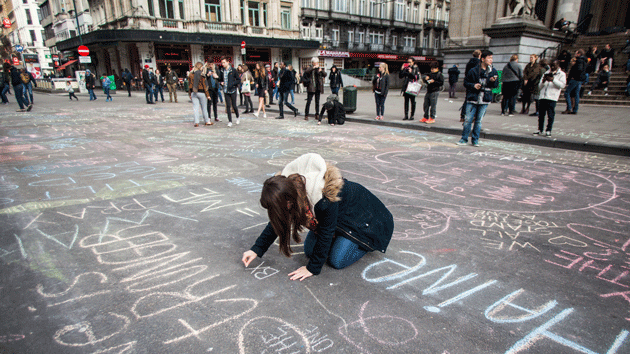
In the aftermath of the Brussels attacks, people write messages of support in front of the Bourse.Kevin Van Den Panhuyzen/ZUMA
With dozens dead following a trio of terrorist blasts that rocked Brussels on Tuesday, Belgium is once again in the spotlight as a hub of Islamic extremism. The Paris attacks that left more than 130 dead last November led law enforcement to the Brussels neighborhood of Molenbeek, where the ISIS militants who carried out the attacks had been living. Before that, a Belgian arms dealer confessed to supplying the weapons used in the Charlie Hebdo massacre in January 2015.
And on a per capita basis, Belgium is the top source of Western fighters in Syria and Iraq, where they have joined Al Qaeda’s Syrian affiliate, the so-called Islamic State, and other groups. According to the latest estimates from Belgian terrorism analyst Pieter Van Ostaeyen, some 560 Belgians have traveled to Syria and Iraq to fight with jihadists, mostly ISIS.
A large number of these fighters can be traced back to the group Sharia4Belgium. Founded in Antwerp and led by a preacher named Fouad Belkacem, the group first gained notoriety by burning American flags following the 9/11 terror attacks. In May 2012, it sent its first fighter, Nabil Kasmi, to the Syrian battlefields, and within months it dispatched dozens more to fight. The 33-year-old Belkacem, a disciple of the British radical Islamist Anjem Choudary, has capitalized on discrimination against Muslims in Belgium and drawing in members through street preaching. Perhaps the group’s most notable recruit is Jejoen Bontinck, a teen who had been a moonwalking celebrity on a TV dance show before becoming radicalized and traveling to Syria. (His father later retrieved him from Syria; their story is told in this excellent profile in the New Yorker.)
In February 2015, Belkacem and 45 members of Sharia4Belgium were convicted of recruiting fighters to send to Syria. Belkacem is now serving a 12-year prison sentence. However much of the groundwork that he and his group laid remains in place. Sharia4Belgium played an important role as an incubator for young Islamists, as van Ostaeyen recently wrote on his blog:
At least 79 members of this former Salafi-Jihadi movement have been active in Syria or Iraq. Furthermore, this group was able to reach new recruits via their social networks. More Belgians got recruited by their old friends on social media, friends, relatives. Yet, a whole lot of other networks were or are recruiting Belgian Muslims for The Islamic State.
Another active jihadist cell in Brussels is a group that formed around an ISIS-linked criminal named Khalid Zerkani. Its recruits include Abdelhamid Abaaoud, one of the attackers in the Paris attacks, according to van Ostaeyen.
Zerkani himself was imprisoned in February 2014. His recruits not only traveled freely to Syria, they also came back as they liked. One of them, Soufiane Alilou, even managed to do so five times before he was caught. Traveling back and forth often seemed to serve the transfer of new recruits, the transport of cash and all of kind of materials, such as computer equipment. Out of the 81 Belgians that have been killed thus far, 13 of them belonged to the Zerkani network.
Meanwhile, Belgian law enforcement agencies are inundated with terrorism-related investigations that are stretching their limited resources. One Belgian counterterrorism official told Buzzfeed News last week that nearly “every police detective and military intelligence officer in the country was focused on international jihadi investigations.” The official, speaking on condition of anonymity, said, “We just don’t have the people to watch anything else and, frankly, we don’t have the infrastructure to properly investigate or monitor hundreds of individuals suspected of terror links, as well as pursue the hundreds of open files and investigations we have.”
















